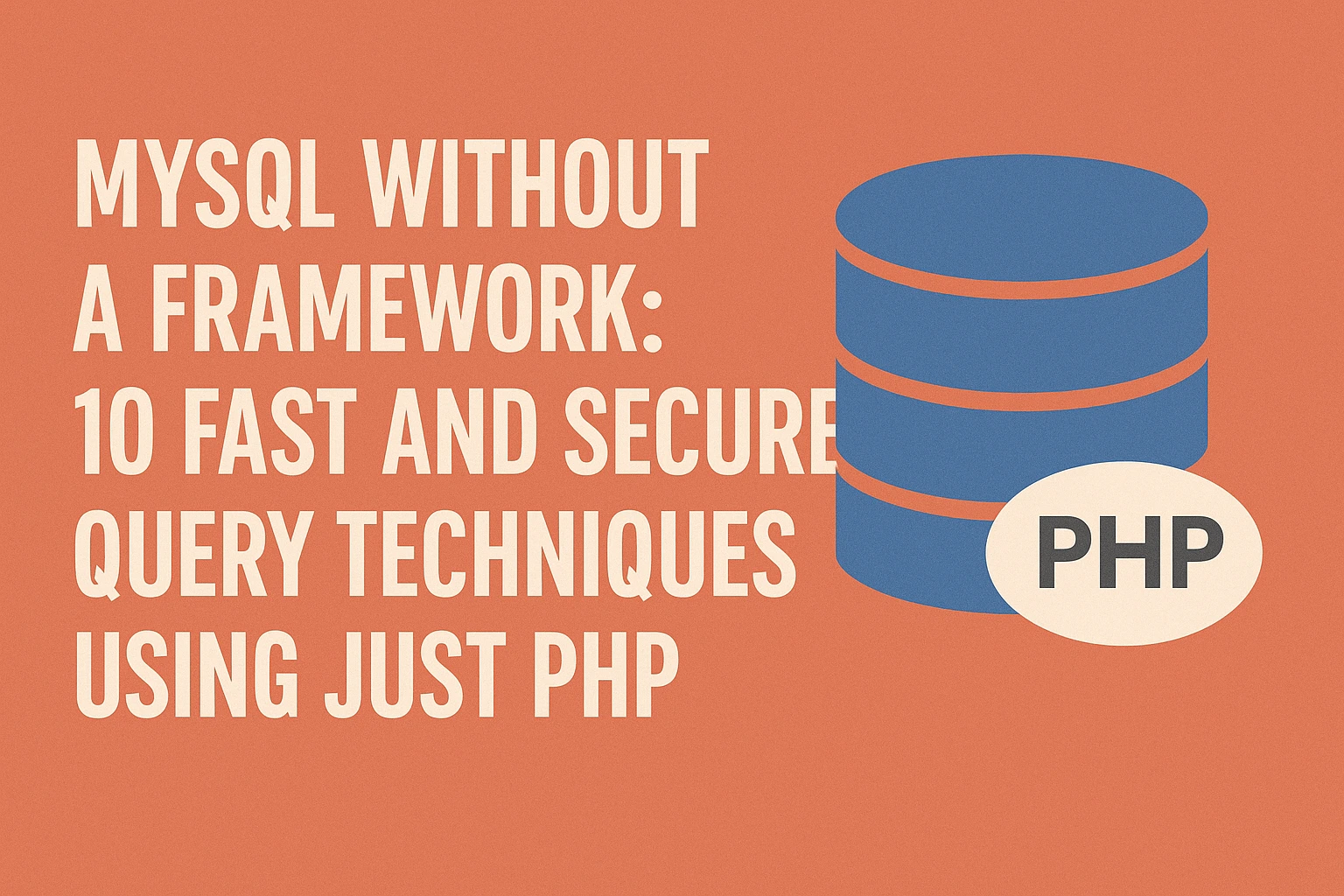Frameworks are great—until they’re not. If you’re working on something small, fast, or just need full control, raw PHP with MySQL is a solid choice.
This guide covers 10 ways to write fast, secure queries without any framework fluff. Just clean PHP, smart SQL, and performance that doesn’t lag.
Let’s dive in.
Key Takeaway
You don’t need a bulky framework to write fast, secure MySQL queries in PHP. With prepared statements, input validation, smart indexing, and clean structure, you can build lean, high-performing apps that stay safe from SQL injection and scale well. The techniques here give you full control—no extra layers, no guesswork. Just pure PHP and smart database handling.
1. Why Skip the Framework?
Sometimes, using a framework feels like bringing a tank to a go-kart race. You get a lot of power, but way more than you need. If you’re building a small app, automating a process, or just need something simple and fast, frameworks can slow you down.
Writing raw PHP with MySQL gives you more control. You decide what happens, when it happens, and how it happens. But you’ve got to stay sharp. One mistake in your query, and boom—your data’s gone or exposed.
2. Set Up PHP + MySQL (The Right Way)
You’ve got two main choices for connecting to MySQL: mysqli and PDO.
// Using mysqli
$conn = new mysqli("localhost", "user", "pass", "db");
if ($conn->connect_error) {
die("Connection failed: " . $conn->connect_error);
}
// Using PDO
try {
$pdo = new PDO("mysql:host=localhost;dbname=db", "user", "pass");
$pdo->setAttribute(PDO::ATTR_ERRMODE, PDO::ERRMODE_EXCEPTION);
} catch (PDOException $e) {
die("Connection failed: " . $e->getMessage());
}
Use PDO if you might switch databases later. Stick with mysqli if you’re staying with MySQL and want procedural options.
Turn on error reporting during development. Silent failures are a nightmare.
3. Prepared Statements: Your First Line of Defense
SQL injection can destroy your data or expose sensitive info. Prepared statements stop that cold.
$stmt = $pdo->prepare("SELECT * FROM users WHERE email = ?");
$stmt->execute([$email]);
$user = $stmt->fetch();
Don’t try to sanitize input manually. Let the engine handle it with bound parameters. It’s safer and faster.
4. Sanitize Input Like Your Job Depends on It
Because it does.
$name = filter_input(INPUT_POST, 'name', FILTER_SANITIZE_STRING);
$email = filter_input(INPUT_POST, 'email', FILTER_VALIDATE_EMAIL);
Don’t blindly trust $_POST or $_GET. Check it. Clean it. Validate it. Always.
Avoid stuffing user input directly into queries. Even if you “checked it.” Use prepared statements every time.
5. Make Your SELECTs Fly with Indexes
Index the columns you search by often. It’s like giving MySQL a map instead of asking it to wander around.
CREATE INDEX idx_email ON users(email);
Test your queries using:
EXPLAIN SELECT * FROM users WHERE email = 'test@example.com';
That gives you insight into how MySQL plans to run it. If you see “full table scan,” that’s a red flag.
6. Simple Connection Pooling
If your app reconnects to MySQL every time it runs a script, you’re wasting resources.
function getConnection() {
static $conn;
if ($conn === null) {
$conn = new mysqli("localhost", "user", "pass", "db");
}
return $conn;
}
Now you reuse the connection across multiple calls.
7. Build Queries Dynamically—Without an ORM
Sometimes you want to generate a WHERE clause from filters.
$filters = [];
$sql = "SELECT * FROM users WHERE 1=1";
if (!empty($_GET['status'])) {
$sql .= " AND status = ?";
$filters[] = $_GET['status'];
}
$stmt = $pdo->prepare($sql);
$stmt->execute($filters);
$rows = $stmt->fetchAll();
You don’t need a whole ORM to write smart, flexible SQL.
8. Pagination That Doesn’t Suck
Pagination with LIMIT and OFFSET works fine… until it doesn’t. On huge datasets, OFFSET can kill performance.
$page = $_GET['page'] ?? 1;
$limit = 20;
$offset = ($page - 1) * $limit;
$sql = "SELECT * FROM posts ORDER BY created_at DESC LIMIT ? OFFSET ?";
$stmt = $pdo->prepare($sql);
$stmt->execute([$limit, $offset]);
For large-scale apps, consider “keyset pagination” using WHERE id < ?.
9. Insert Smart, Insert Fast
$sql = "INSERT INTO users (email, name) VALUES (?, ?)";
$stmt = $pdo->prepare($sql);
$stmt->execute([$email, $name]);
Need to avoid duplicates?
INSERT INTO users (email, name) VALUES (?, ?)
ON DUPLICATE KEY UPDATE name = VALUES(name);
For large data imports:
INSERT INTO table (col1, col2) VALUES
(?, ?), (?, ?), (?, ?);
Batch inserts save time and reduce I/O overhead.
10. UPDATE and DELETE with Brakes On
Don’t write an UPDATE or DELETE without a WHERE clause. Ever.
$stmt = $pdo->prepare("UPDATE users SET status = ? WHERE id = ?");
$stmt->execute(['inactive', $userId]);
Use transactions when making multiple changes:
$pdo->beginTransaction();
try {
$pdo->exec("UPDATE users SET status = 'archived' WHERE id = 1");
$pdo->exec("DELETE FROM sessions WHERE user_id = 1");
$pdo->commit();
} catch (Exception $e) {
$pdo->rollBack();
}
Keeps your data safe when things go sideways.
11. Keep an Eye on Performance
Don’t wait until your app crawls to start profiling.
Use microtime(true) before and after queries:
$start = microtime(true);
$stmt = $pdo->query("SELECT * FROM logs LIMIT 1000");
$end = microtime(true);
echo "Query time: " . ($end - $start);
Look into SHOW FULL PROCESSLIST to see what’s stuck.
12. Bonus: Organize Your Code Without a Framework
Even if you skip the framework, don’t skip structure. Keep your logic separate from HTML. Use functions and classes. Store queries in one file. Group related operations together.
/db/connection.php/db/user_queries.php/logic/form_handler.php
Simple structure, simple life.
Final Words
You don’t need a heavy framework to write clean, secure, and fast PHP apps. Just stick to the basics, protect your queries, and think ahead.
Working without a safety net teaches you things a framework hides. But you’ve got to respect the process. Every query is a loaded gun—point it carefully.
Let me know if you’d like a downloadable version or if you want me to turn this into a tutorial series.

Leave a Reply